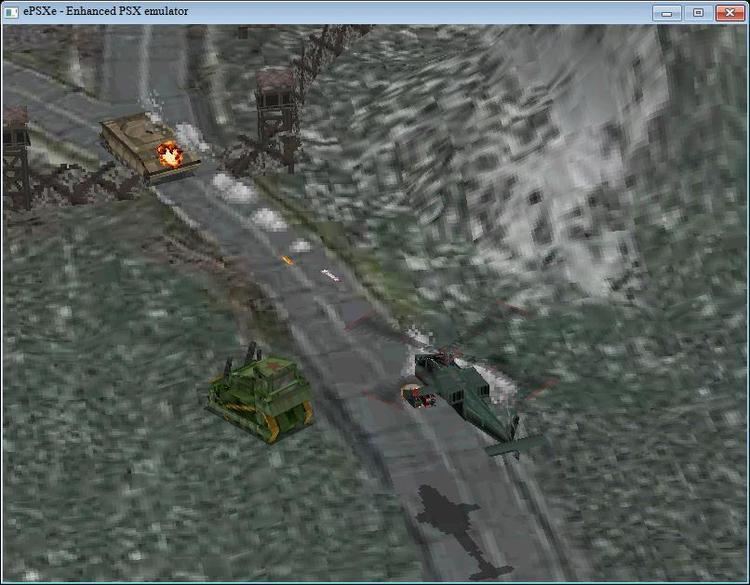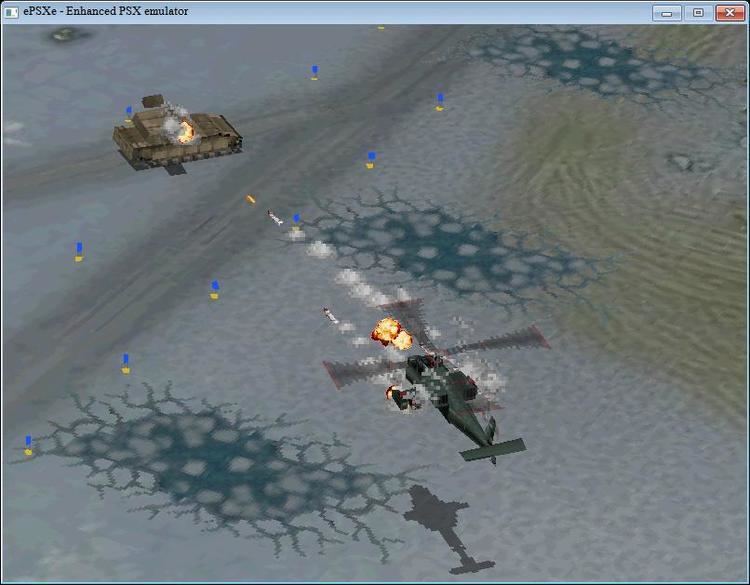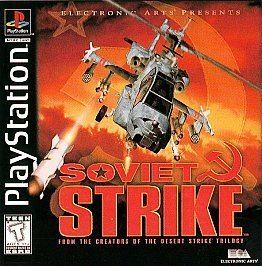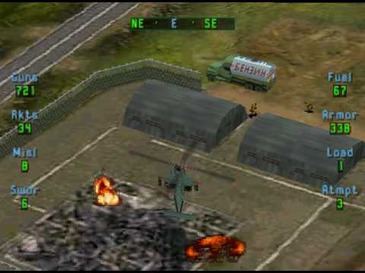9.8 /10 1 Votes
4.9/5 CoolROM Initial release date 31 October 1996 | 4.9/5 Emuparadise Mode(s) Single player Series Strike Genre Shooter game | |||||||||||||||||||||||||||||||||
 | ||||||||||||||||||||||||||||||||||
Similar Strike games, Adventure games | ||||||||||||||||||||||||||||||||||
Cgrundertow soviet strike for playstation video game review
Soviet Strike is a helicopter-based shooter game developed and published by Electronic Arts for the PlayStation in 1996 and the Sega Saturn in 1997. The game is a sequel to the Strike games which began on the Sega Mega Drive with Desert Strike: Return to the Gulf. Soviet Strike is the series' first installment for a 32-bit console and was first conceived as 32-bit Strike. Early on, it was intended for the 3DO console, before development changed to the PlayStation.
Contents
- Cgrundertow soviet strike for playstation video game review
- Soviet strike ps1
- Gameplay
- Characters
- Plot
- Development
- Reception
- References

Soviet Strike is set after the disintegration of the Soviet Union, and takes place in a fictionalised Russia, Eastern Europe and around the Caspian Sea. The player pilots an Apache helicopter and battles with the forces of Shadowman, a renegade ex-Communist figure. Like its predecessors, the game features shooting action mixed with strategic management of fuel and ammunition, but has more authentic 3D graphics, as well as a modified overhead - as opposed to isometric - perspective. The game also features a more realistic enemy artificial intelligence and environment. Critics received the game positively, praising the graphics and full motion video, while commentary on the gameplay and difficulty was more mixed.

Soviet strike ps1
Gameplay

Soviet Strike is a helicopter-based shooter game. As in its predecessors, the player views the action from outside his craft, using one of two available viewpoints. These are similar to the isometric perspective of the previous games, but are improved "overhead" versions. This removes the predecessors' problem of buildings occasionally obstructing the player's view; and unlike the previous games, the player can no longer collide the helicopter into structures, instead always flying over them. The first camera system fixates on the Apache, while the second "allows you [the player] to rotate the screen around the helicopter". The Apache is armed with a machine gun, Hydra rockets and Hellfire missiles, which vary in power and payload. The Sega Saturn version includes two hidden power-up weapons: doubled machine guns and Maverick missiles. The craft has finite ammunition, fuel, and armour, and the player must manage the payload by collecting limited supplies.

The game has five large levels, each divided into several missions. Mission objectives include seeking and destroying enemy personnel and structures such as radars, training camps and ships; rescuing prisoners-of-war and other persons (including, in one mission, Boris Yeltsin), as well as recovering intercontinental ballistic missiles and capturing enemy commanders and agents. Soviet Strike employs a relatively realistic, fluid virtual battlefield and sophisticated artificial intelligence, which will put in motion set pieces even if the protagonist has not arrived to take part. The opposing intelligence can track the player using radar and reinforce positions accordingly. As such the player must sometimes pre-emptively destroy radars. Enemy troops may also flee once they have lost a battle. Some missions require set piece solutions, including "starting an avalanche to crush a tank battalion and sealing a nuclear reactor core in a salt mine." The game is "very tightly structured", yet the player has the ability to roam the battlefield attacking enemies at will.
Characters
The player is a helicopter pilot in STRIKE, a special covert operations force of the US military designed for preemptive action to prevent "wars that never happen." STRIKE's commander is General Earle, who has electronics expert Hack and agent Andrea Grey (whose cover job is a news reporter) working for him. The other protagonists are STRIKE asset Nick Arnold, guerrilla fighter Amad, and former Soviet Army pilot Ivan Uralia. The game's antagonists are former KGB Chairman Uri "Shadowman" Vatsiznov, Ireki dictator Sadissa Savak, and disgraced Soviet scientist Dr Grymyenko Ukrainian.
A series of voiceovers called STRIKE Files outline the origins of STRIKE. One such file has the Security Czar detailing the organization's mandate to US President Bill Clinton after his inauguration in January 1993. In the tape, Clinton is unaware that STRIKE prevented a civil war in Mexico in 1982 which could have turned the country into a secret Warsaw Pact member-state.
Plot
The end of the Soviet Union leaves a power vacuum in Eastern Europe that former KGB Chairman Uri Vatsiznov, AKA the Shadowman, is willing to exploit for his own ends. In the first mission, which takes place in the Crimea, the player must rescue a captured spy named Nick Arnold to retrieve intelligence on the game's antagonist. The second level is set in the Sea of Azov: the player must battle the elements of the Black Sea Fleet which is preparing to invade Europe. The mission also involves the rescue of guerrilla fighter Amad.
STRIKE's victory in the Black Sea leads them to the Caucasus, where Sadissa Savak, leader of the fictional state of Irek, begins aggressive overtures against local fighters. In the mission (which is supposedly north of the main battle area where Desert Strike took place), the player and Amad join forces with a militia run by Amad's relatives in stopping Ireki troops from capturing an ex-Soviet chemical weapons plant. With STRIKE killing Savak (and passed off as the victim of a car crash), the group goes to a heavily irradiated Transylvania to rescue Nick once more, this time from Dr Grymyenko Ukrainian, who wields an arsenal of ballistic missiles. The player is also tasked to kill the Shadowman's lead armor commander, Vila, who operates a special red-turreted T-80, and aid in the destruction of an abandoned nuclear reactor the Shadowman is planning to use.
The final mission takes place in Moscow, with Shadowman's unleashing his minions in the KGB, the military and the Russian mafia in attempting a coup against President Boris Yeltsin's government. The player must prevent a bombing on the Kremlin before seeking out and killing Shadowman. The game's end sequence depicts Andrea delivering a televised news report blaming the destruction on an earthquake and consequent gas fires.
Development
Soviet Strike began development as a game for the 3DO under the working title of 32-bit Strike. Strike series creator Mike Posehn assisted in early programming and the design but otherwise did not wish to work as part of a large team, necessitated by the move to a more advanced console. The development team, who had already spent several months working on the 3DO version, decided to rework it instead as a PlayStation game when it was clear that the 3DO's demise was inevitable; an additional two years' labor time was the result. The team re-evaluated the basics of the 16-bit games and aimed to create more lifelike environments and enemy behaviour. The 3D engine - created by the Road Rash 3DO team - used satellite images of real topography, imposed on polygonal maps. It also modified the preceding isometric viewpoint - which caused buildings to obstruct the player's view - to an overhead perspective with which the player could move and see over terrain and structures. Unlike some of its predecessors, Soviet Strike features only a helicopter - albeit with power-ups in some levels - and the team also abandoned the unpopular on-foot levels found in Urban Strike. The developers aimed to include more humour in the game, with other additions being voice-overs and full motion video.
The later Saturn version featured a number of changes: an optional easy difficulty setting (providing the player with twice the fire-power and slower fuel consumption), adjustable brightness on the heads-up display; two hidden powerful weapons; hundreds of bug fixes from the PlayStation version; extra sound effects added to helicopters; improvements to the graphics of control and menu screens and compass; stereo and mono versions; cow sound effects; and more improvised fuel added to level 4. It was also compatible with the Saturn's then-recent analogue controllers. The game was followed by a further sequel, Nuclear Strike, released for the PlayStation in late 1997.
Reception
Reviewers said the terrain graphics were "realistic", "nearly photo-realistic", "photo-realistic" and "Superb". Others called them "gorgeous". Reviewing the Saturn version, GameFan said the terrain "looks amazing". Next Generation said: "the game makes a giant leap forward in terms of the environment" but called the explosions "average", while those of the Saturn version impressed reviewers. GamePro said the "explosions are satisfying eye-candy". Jeff Gerstmann said the vehicles "look good", while another reviewer called the structures "highly realistic". Next Generation felt the structures and vehicles together with the terrain formed an "impressive" environment. The magazine felt the animation to be "average"; Gerstmann called it "choppy" but overall felt the graphics an improvement over the game's predecessors on older systems. GameFan's Saturn review summarised the graphics as "first-rate", while Russian magazine Great Drakon also praised them.
Critics called the full motion video "stylish", and praised the acting. Gerstmann said the FMV had "some of the best CD-ROM acting seen in a long time" and called it the game's "only real plus". Edge noted the new video but felt it was "over-the-top" and intrusive, while others disagreed. GamePro compared the FMV to Desert Storm if reported by MTV, saying its "hip new attitude" was "part of the charm", while another critic said the sequences "spice up the proceedings a fair bit". Great Drakon also praised the FMV. Reviewing the Saturn version, GameFan noted a poorer quality of FMV than the PlayStation version. Gerstmann felt the sound to be "dull", while Next Generation called it "exemplary". Others praised the quality of the gunfire sound effects, and noted humour in the enemy troops' utterances.
Gerstmann noted "a raw collection of messy operations", while Edge praised the game's "inventiveness" - saying it "makes Soviet Strike" - as well as the variety added by the games artificial intelligence. The magazine also felt that while the collecting of supplies added strategy to the action, the limited amount restricted the paths the player might take through the level. Another critic said the "real-time, living battlefield enhances the urgency of the missions and the player's involvement" and also noted "practically no load time." GameFan complained of a high difficulty and a steep curve, long levels which return the player to the beginning should he die, infrequent opportunities to repair armour and the enemies' tendency to attack the player from beyond his limited viewpoint, and was thankful for the Saturn version's optional easier difficulty setting. Next Generation also criticised the player's restricted view, calling it the game's "worst problem". One reviewer said revisiting levels to discover missed set pieces aided the game's longevity; Sega Saturn Magazine had "some reservations" about the game's replay-value, with only 5 missions, but said it was "very playable and enjoyable", while another reviewer called it "a load of fun". Gerstmann criticised the poor scrolling, erratic motion and imprecise control, Great Drakon praised the controls, while GameFan noted they had improved in the Saturn version. The reviewer also enjoyed this version's new weaponry. Another reviewer pointed to some "minor flaws", saying the HUD "smacks of 16-bit era graphics"; The game impressed Great Drakon's reviewer, who praised the attention to detail and the reviewer found the story convincing. IGN said: "Everything about this game is great. Excuse me for gushing, but when you come across a game that's as fun to play as Soviet Strike, and great looking, you really sit up and take notice."
Gerstmann called the quality FMV "a small victory in a larger conflict", saying the game had "too many little problems to recommend it" and that it "simply doesn't play as well as the old 16-bit Strike games." Sega Saturn Magazine called it a "worthy addition" to the series and also noted improvements to the Saturn version. GameFan said the game "is everything you could wish for from a 32bit Strike" and that "it plays brilliantly, and exercises both your trigger finger and grey matter." The magazine later reflected that the Saturn version was somewhat better but nevertheless very similar to the PlayStation original. It recommended the game to Strike fans but felt it would be an "in at the deep end" introduction for newcomers to the series. Edge summarised: "this is a fairly well-engineered continuation of the four-year-old Strike series", which retains the gameplay of the original but updates the graphics to true 3D. GamePro felt the game might be too slow for fans of faster paced action games, but recommended it for players of previous instalments in the series. Allgame later felt: "The series peaked with the release of Soviet Strike."
